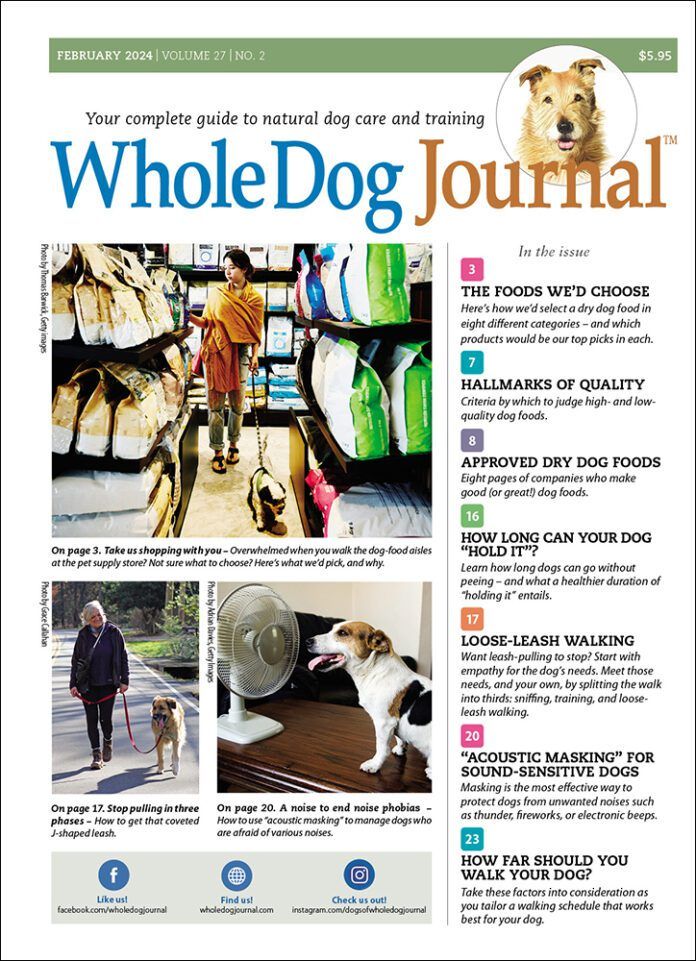- The Foods We’d Choose
- Hallmarks of Quality
- Approved Dry Dog Foods
- How Long Can Your Dog “Hold it”?
- Loose-Leash Walking
- “Acoustic Masking” for Sound-Sensitive Dogs
- How Far Should You Walk Your Dog?
Download The Full February 2024 Issue PDF
The Velcro Dog

A “Velcro dog” is a clingy dog who wants to be where you are, no matter what and no matter where. Many of these dogs follow their owners from room to room, even into the bathroom. Some breeds, like the Cavalier King Charles Spaniel, just naturally desire closeness. My dogs are always in the same room as me. As I write this article, they’re all settled in my office for a nice nap. But they’re equally fine with my husband or home alone. They desire closeness, but they’re confident when alone, too.
The Difference Between a Velcro Dog and Separation Anxiety
When you leave your home, a healthy Velcro/clingy dog quietly waits for his owner to return. If he destroys the home and/or injures himself when you’re not in his sight, it’s a problem. This is called separation anxiety.
A dog with separation anxiety may engage in behavior that destroys household items and even harms himself. This dog may need behavior training and/or medication. Note: An older but often referenced study found that separation anxiety doesn’t develop just because a dog is “spoiled,” but it is more likely to occur in homes with one dog and one human.
Fear, Pain, or Discomfort Can Make a Dog Clingy
If your dog changes and needs to be by your side every minute, and it is out of character for him to behave like this, then perhaps he’s not feeling well. If a dog is in pain, he may go to his owner for comfort. Bring him to the veterinarian to make sure there’s nothing wrong with him.
Another reason a dog might suddenly find the need to stick to you like Velcro is fear or an unsettling household change:
- Is there a new member of the household that the dog is uncomfortable with?
- An uncle that’s a little too rough or loud?
- A new baby that makes high pitched noises?
- Are you having workers in the house?
- A toddler who just learned to stomp and throw toys and scream?
- Or maybe the new puppy is just too much for your older dog (or vice versa).
My dogs were clingier while we were having noisy house repairs done, with strange men hammering all day. My dogs never left my side until the workers started bringing them (owner-approved!) treats. Dogs like routine. And any time that routine changes, it can cause him angst, and he will seek protection from you. Or he may think he’s protecting you.
Many rescue dogs or puppy-mill dogs, who have finally found their forever home, get anxious when they are asked to leave your side. They need to be close to you every minute because they are insecure and possibly fearful. Who knows what kind of environment they have experienced in the past?
When you leave, they are not sure if you will be back, so they don’t want to let go. Hopefully, they will learn that you return every time, and they will be able to rest while you’re gone. Often, medications from your vet will help to relieve the anxiety until they feel that you are not deserting them.
For some of these dogs, teaching them you will be back is as simple as practicing. You leave them alone for 20 seconds and return and give them a treat. You gradually increase the time away, over the course of a week or two, until they realize that, “Oh, Mom is leaving! She’ll be back and I will get a treat.”
Many dogs also relax more if they go to their spot or their cozy crate before you leave. It keeps them safe, and it reminds them that this is what they do while you’re away from home and, when you return, you’ll let them out.
Helping a Velcro Dog
Several dogs enrolled in my Basic class each session cling to their handlers out of fear. They just cannot come out from behind their owners. We simply carry on with the class, have fun and play with toys, with dogs getting lots of treats for doing simple exercises. Eventually, the shy dog takes interest in the class and wants to join in. Within six weeks, we have a more confident pet who is a little less clingy.
There was one Chihuahua, however, that I remember from a few years ago, who never came out from behind his owner. The owner came to class each week, her dog hiding behind her. She learned how to teach various exercises, went home and taught Muffin. The result was a very shy, albeit very well-trained dog. And everyone was happy.
I hope that you are lucky enough to have a dog who loves you so much he wants to be by your side, is comfortable with you leaving him at home for a bit, and greets you with barking, spins, and kisses when you arrive back at home. And as the moon rises, it finds you cuddled up together in a chair under a warm blanket.
Pyometra in Dogs

Pyometra is a bacterial infection of the dog’s uterus. It can be life-threatening and requires prompt veterinary attention. It occurs in unspayed dogs although, rarely, in a spayed dog. If it occurs in a spayed dog, it’s because a small piece of uterus remained after the spay and that is still susceptible to infection (this is called “stump pyometra”).
Symptoms of pyometra in dogs include:
- Increased water intake
- Lack of appetite
- Lethargy/weakness
- Fever
- Vomiting
- Painful abdomen (may be distended)
- Possible purulent discharge from the vagina
Causes of Pyometra
Pyometra develops when infectious bacteria invade the uterus. This is most common shortly after a heat. The cervix is loose during a heat, so bacteria easily gain access to the uterus, and the uterine lining is built up enough during heat to provide the perfect growth medium for bacteria, E coli in particular.
Diagnosis of Pyometra in Dogs
Diagnosis is generally done via a veterinary exam with palpation of the abdomen followed by radiographs or ultrasound. The uterus will appear distended. Bloodwork, especially a complete blood count (CBC), will indicate an infection.
Antibiotics to Treat Pyometra
Since it’s a bacterial infection, antibiotics are prescribed. While it’s preferable for the veterinarian to do a culture and sensitivity test to choose one, time is often of the essence, so your veterinarian may make the decision based on what has worked well in the past.
The most commonly used antibiotics, according to a survey of 152 veterinarians, published in Veterinary Medicine and Science (May 2023), are:
- Amoxicillin/clavulanate potassium (86%)
- Enrofloxacin (52%)
- Cefazolin (37%)
- Ampicillin/sulbactam (22%).
Closed Pyometra
Some dogs will have “closed pyo,” which means the cervix is tight enough to prevent any discharge. This can complicate both diagnosis and treatment.
The most common treatment for this is an ovariohysterectomy or spay. Note: This surgery is more complicated than a standard spay because the dog’s uterus is swollen with pus and the tissues are friable and fragile. In addition, the dog is fighting systemic illness from a serious infection. She will need to be on IV fluids, monitored carefully throughout surgery and post op, and receive antibiotics to fight the infection.
Open Pyometra
In “open pyo,” the cervix is not closed and the purulent material is draining out. In these cases, medical management with the use of prostaglandins may be attempted. This is most common with a valuable brood bitch whose owners would like another litter. If medical treatment is not successful, surgery is necessary.
How to Show Your Dog You Love Them
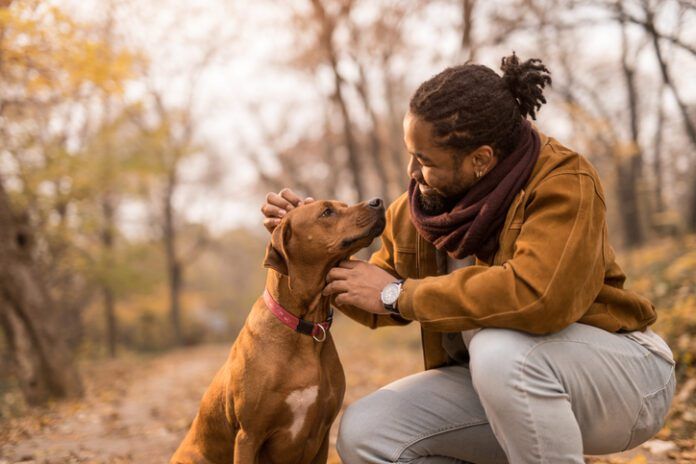
Humans tend to naturally want to demonstrate their love with hugs, petting, and cuddles – and some dogs love being hugged, petted, and cuddled, too! But others don’t. The best way to show your dog your love is to pay close attention to what she likes and then provide the kind of touch, eye contact, and interaction that she enjoys best – and to avoid imposing your preferred or unconscious way of petting or play on a dog who signals that she is uninterested or avoidant.
To determine what kind of touch and attention she really loves, try a “consent test”: Sit near your dog. When your dog approaches you, initiate contact. The best first contact is usually a scratch on the chest (not on top of the dog’s head, few dogs like that!). Scratch or pet her for about three seconds, then remove your hand. If your dog moves closer or nudges your hand and has a relaxed facial expression, she is inviting more physical contact.
If you have a lap snuggler, by all means, indulge. If your dog prefers scratches under the chin or a calming massage, do that. If she likes making direct eye contact with you, spend long moments gazing lovingly into her eyes.
Dogs can change their minds, so even if yours invited additional petting at first, be alert for signs that she has had enough and wants the petting to stop. If she moves away, let her go! Think about where and how you were petting her when she decided to move away; she may not like that particular type of contact! (For more detailed information about consent testing, see, “Does Your Dog Opt In? How to Communicate With Your Dog.”)
Loving Alternatives to Touch
Be aware that some dogs would rather not be touched at all! If your dog is one of these, show her that you love her with activities that she enjoys. The more adventures that she enjoys with you the most strongly she will associate you with the pleasure she feels during these activities.
If walks are her favorite activity, commit to regular walks in the woods or “sniffari” adventures, giving her as much time to smell all the smells that she wants. If she prefers rousing games of tug, fetch, or find-the-hidden treat, try to indulge in these games at least once a day, if not more, if only for a few minutes each time.
Don’t forget training! Relaxed, fun, force-free training can make your dog feel connected, understood, and loved by you! It’s communication, after all. Plus, a well-trained dog can enjoy many privileges: visits to homes of friends and family, public outings around other dogs and humans and other animals, and even off-leash hikes and canine sports.
Keep in mind that even if it’s well intentioned, old-fashioned training that uses coercion or the faulty “dominance” concept has been scientifically demonstrated to damage a dog’s well-being and quality of life. A happy voice, warm praise, clear cues (rather than “commands”), and gentle handling will tell your dog you love her. Force-free tools and methods that help build relationships based on mutual trust, respect, consent, and cooperation are a true demonstration of your love for your dog.
Can Dogs Have Butter?

Dogs love butter as much as we do, but butter is high in fat and not easily digested by dogs. Although butter is not toxic to dogs, it can make them sick if they ingest large amounts. Repeatedly offering your dog butter can lead to obesity, chronic pancreatitis, high cholesterol, and heart disease. Although we like to spoil our pups, take butter off the treats list, and there are far better ways to help him gain weight, if needed.
Symptoms in Dogs Who Ate Butter
Dogs who ate a small amount of butter may not have any symptoms. However, dogs who ingested larger amounts may experience vomiting and diarrhea. Your dog may have a decreased appetite, a painful belly, and a lethargic demeanor. If the butter was salted, many dogs will drink and urinate more often. Symptoms of pancreatitis include loss of appetite, vomiting, diarrhea, weakness, and abdominal pain.
What Will a Veterinarian Do If My Dog Ate Butter?
Depending on the size of your dog and how much butter he ate, your veterinarian may advise you to bring your dog in immediately for treatment or may recommend you monitor him at home for signs of gastrointestinal upset.
If he has to go into the clinic, a physical exam and bloodwork will be performed first. Depending on how sick he is, he may receive intravenous fluids, pain relief, and antinausea medications while hospitalized. These treatments will be continued until he is feeling better.
Reading Stressed Dog Body Language

Whining is often an indication of stress, but it’s your dog’s body language that tells you the most. Watch your dog, starting from the tip of his nose. Stressed dogs lick their noses nose and lips frequently, pant (without being hot or having just exercised), and frequently yawn.
Many dogs will avoid eye contact, show white around their eyes (whale eye or side eye), or have dilated pupils. Ears pinned back tightly often indicate an anxious, uncomfortable dog.
Dog Turns Away
Often a stressed dog will turn his head or even his whole body away, likely hoping to avoid any confrontation. He may sniff to appear uninterested in a worrisome situation. His hair may loosen, so he suddenly “sheds” when you pet him in a stressful situation. The tail may be tucked tightly underneath and up against his body. He literally may be shaking or trembling.
The dog may pace, if possible. You may also notice:
- Barking
- Circling
- Compulsive licking at a limb creating a “lick sore”
- Cowering
- Destructive behavior like tearing up his bed or destroying household things
- Diarrhea
- Dilated pupils
- Excessive drooling
- Flattened ears
- Front paw lifting
- Head shaking
- Heavy panting
- House soiling
- Losing control of bladder or bowels
- Loss of appetite
- Low activity
- Nose licking
- Obsessively licking one spot
- Refusing to look directly at something
- Restlessness/pacing
- Scratching himself
- Shut down (withdrawn, unresponsive to stimuli and people)
- Shying away from/refusing to move toward something
- Trembling
- Vomiting bile
- Whining/vocalizing
- Withdrawal from family/less interactive
- Yawning (when obviously not sleepy)
How to Help a Stressed Dog
If you notice any signs of stress in your dog, remove him from what is causing the distress, if possible. That may mean walking away or doing a detour around a scary area. You must be his advocate and step between him and whatever is concerning him, whether it’s people, other animals, or a physical situation. Once he’s moved away and seems to be settling, let him look at the stressor.
Controlling your dog’s stress is a health measure because chronic stress can cause high blood pressure, gastroenteritis, weight loss, delayed healing of injuries, less resistance to infections, and sometimes to the development of obsessive-compulsive habits such as licking or chewing.
What Foods Are Toxic To Dogs?

What foods are toxic to dogs? More than you may realize! While ingesting something he shouldn’t, like a dead animal carcass, is probably going to make your dog sick, eating a toxin can cause his death.
Dog owners frequently ask about:
- Are grapes toxic to dogs? Yes. They’re deadly, but research has yet to pin down how many grapes it takes. Don’t feed grapes!
- Are raisins toxic to dogs? Yes (they’re dried grapes).
- How much onion is toxic to dogs? A medium onion could kill a medium dog.
- Is garlic toxic to dogs? Yes. It’s lethal at even smaller amounts than an onion.
- Are almonds toxic to dogs? No, but they are difficult for your dog to digest and may cause a bowel obstruction.
The point is, watch what your dog eats, and if you’re not sure and see signs of poisoning, get to a veterinarian immediately or call a poison control center (it will cost you, but your dog is worth it). Even veterinarians call these centers for advice because time truly is of the essence in a poison case:
- The ASPCA Poison Control Center (888) 426-4435.
- The Pet Poison Helpline at (855) 764-7661.
Almost all these substances cause vomiting and/or diarrhea, symptoms that should at least get your attention. Others cause depression, panting or respiratory depression, tremors, or weakness, especially of the hind legs. If those symptoms develop, your dog probably needs immediate veterinary attention.
Common Foods That are Toxic to Dogs
You might be surprised that the most common foods that are dangerous to dogs are common in most households. Here are 10 common foods that the National Library of Medicine says are toxic to your dog:
- Onions, whether raw, cooked, or powdered. They contain a compound (n-propyl disulfide) that breaks down red blood cells, the cells that provide oxygen to tissues.
- Garlic is about five times more toxic than onions, even though microdoses have been used by some researchers to promote health.
- Chives are, like onions and garlic, a member of the Allium family. Symptoms include lethargy and depression, pale gums, rapid breathing, elevated heart rate, vomiting and diarrhea.
- Chocolate contains theobromine, which is similar to caffeine. It can cause heart issues, tremors, seizures, and death. Dark and unsweetened chocolate are the most dangerous.
- Caffeine is the active ingredient in coffee. Who knows why you would allow Fido to drink coffee, because it causes all the problems chocolate does?
- Tea contains caffeine, so it’s toxic. Don’t be fooled by the label “organic”- it contains caffeine, too. Herbal teas don’t contain caffeine, though.
- Macadamia nuts. No one knows why they can cause toxicocis, but the symptoms include weakness of the hind legs, vomiting, tremors, and hyperthermia. Toxic reactions to macadamia nuts need immediate veterinary care.
- Avocados are also great for humans but horrible for dogs. They contain persin, a fungicidal toxin not harmful to humans that causes vomiting and diarrhea in dogs. They also contain lots of fat, which dogs digest poorly, and they can choke on the large pit too.
- Artificial sweetener (xylitol or birch sugar) causes a drop in blood sugar in 15 to 30 minutes, so he’ll need immediate veterinary attention before it causes weakness, staggering, seizures, liver failure and even death.
- Alcohol causes much the same symptoms as in humans–only worse–because their liver is much smaller.
If that’s not enough, many common plants are toxic to your dog. Rat poison, of course, is deadly, especially if it’s the really bad stuff. Frogs can make dogs sick, while toads can kill them. And summer’s coming! Beware of blue-green algae.
How to Give a Dog a Pill
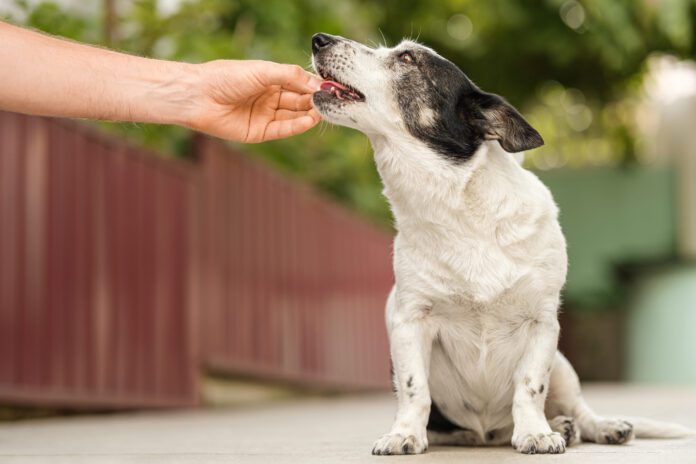
Sometimes, giving your dog a pill is unavoidable. Maybe the medication isn’t available in another form (although it often is) or the cost difference between the pill and other forms of the medication is prohibitive. Ask your veterinarian whether the medication can be compounded into a suspension (liquid) or flavored chewable tablet, but if a pill is the only option, know that sticking your hand in the dog’s mouth is truly not a wise choice.
Pill Disguises
The most common method is to bury the pill in an irresistable treat. The more high-value and tastier the treat, the better. High-value treats include:
- Canned dog or cat food
- Baby food
- Baked chicken that is moist enough to engulf the pill
- Soft cheese, like string cheese
- Hot dogs
- Pill pockets (homemade or commercial)
If the pill is large, cut it into multiple pieces and place them in several treats. You can also pulverize the pill and mix it into canned food.
Try a Pet Piller
Whole Dog Journal is reader-supported. If you purchase through links on our site we may earn a commission. Whole Dog Journal does not accept money for its food and product reviews.
Sometimes a pet piller can help, especially if your dog will not take it in food. Manually pilling your dog may become necessary if he is not willing to swallow the pill on his own, and a pet piller like the VetOne Pet Piller can help if your dog still refuses the pill in a treat. After using the piller to get the pill in the back of your dog’s throat, you can massage his throat after he begins the swallowing process to stimulate swallowing
When learning how to give your dog a pill, aim to complete the experience as positively as possible, and this video from a veterinary clinic does an excellent job showing you exactly how to do both give pills and keep things positive. Remember to follow the pilled treat with a regular treat and lots of praise.
What NOT to Say to Shelter and Rescue Workers
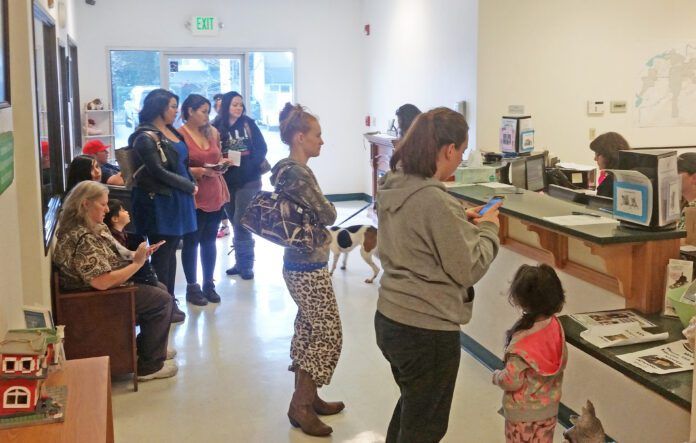
Whenever I spend any time at my local animal shelter as a volunteer, I am filled with empathy and admiration for the people who work at the front desk. The drama they witness! The tragedies they must deal with! The hostility they have to endure at times!
All day, every day, front-desk shelter workers are confronted with people who are sad and upset and/or angry and frustrated. Perhaps most frequently, they deal with people who are upset about having to pay money to retrieve their dogs, whether the dog had been brought into the shelter by a member of the public who saved the dog from trotting down the middle of a busy road, or had been picked up by an animal control officer from the yard of a citizen whose cat had been killed by the dog. Fees are charged for holding dogs, and for a lack of proof of rabies vaccination and/or licensing, and these fees are deliberately set at higher rates for intact animals (both as a lever to encourage people to spay/neuter their pets, and to help address the cost of the puppies that often result from the adventures of intact dogs who have gone astray).
All I can say is, if my dog had been running at large and someone caught him and brought him to the shelter, I’d be thrilled that he had been apprehended and removed from all the potential dangers of the streets. But if my dog had been what the shelter calls a “frequent flier” – constantly escaping and getting caught running at large – I could see how those fines would be upsetting. But the fines are not set by the front-counter staff, and it’s not their fault that the dog got out!
As daunting as it may be to deal with people who are angry when retrieving their animals, I think that it may be even more stressful for front-counter workers at the shelter to deal with people who are trying to rid themselves of unwanted dogs and/or puppies.
Don’t get me wrong; there are plenty of valid and very sad reasons that can cause people to surrender dogs to the shelter – and I’ve seen how kind the intake staff can be at those times.
But it’s the people who either lie and try to pass off their own dogs or puppies as strays that someone else “dumped” on their property, or who are hostile and combative when staffers ask for a surrender fee for taking the unwanted dogs or pups that I would find most challenging. These folks don’t care that the shelter spends an average of $300 per animal on vaccinations, medications for sick animals, flea-control products, dewormers, a microchip, and spay/neuter surgery – they are often pissed when asked to fork over half of that cost as a surrender fee.
I was present at the shelter one day when I saw a woman storm out of the lobby into the parking lot screaming over her shoulder, “F*** you! This is your job! Just do your damn jobs!” When I asked my friend at the front counter what made the woman so mad, he shrugged and said, “We told her that we couldn’t take her dogs today – the shelter is 100% full – and she just hit the roof. We told her we could call her back when we have room, but she wanted to surrender three dogs right now!” The shelter workers can offer other alternatives or ideas to people who are in a bind with animals that they can’t keep, but they are somewhat unmotivated to do so when someone is screaming at them for their failure to immediately solve a problem of that other person’s creation.
Many times at the shelter, I have thought, “I could never work here! I’d never be able to keep calm with some of the people the shelter staffers have to deal with!” But I don’t say that to my friends at the shelter – and I hope you don’t tell your friends in rescue or shelter anything like that, either. Because what we really mean when we say things like that – and what I do tell my friends at the shelter is, “I so admire and appreciate your work here. It looks very difficult, and you handle it with grace and grit. Thank you!”
Can Dogs Drink Oat Milk?

Oat milk can be good for dogs. It’s a lactose-free dairy alternative for humans that dogs also can enjoy, but in moderation.
Oat milk without additives has fewer calories, fat, and protein per serving than regular whole milk and can be nutritious treat for your dog. Start slowly, though, and check with your vet first if your dog has any health conditions like diabetes or special needs.
Oat Milk for Dogs
Diana Laverdure-Dunetz, a vegan canine nutritionist in Florida, recommends serving your dog homemade oat milk made from only two ingredients: organic, certified gluten-free oats and water.
That means the best oat milk for your dog is homemade. Commercial oat milk products may contain ingredients that are unsafe or unhealthy for dogs, like added sugars, preservatives, flavors, oils, and thickeners. Recipes are abundant online, and it’s a fairly simple process.
“Oat milk contains a type of soluble fiber called beta-glucans, which offers many health benefits, including stimulating the immune system, protecting against infectious diseases, fighting cancer, and helping stabilize blood sugar levels. Soluble fiber also offers a variety of gastrointestinal benefits, including controlling large bowel diarrhea and promoting a healthy gut microbiome. Oats also contain antioxidant compounds that protect cells from oxidation and are a good source of many vitamins and minerals.”
Problems With Oat Milk for Dogs
Obviously, dogs with a food intolerance to oats should not have oat milk. Laverdure-Dunetz also says oat milk should never be given to puppies because they should rely on their mother’s milk. Also, since oat milk contains fiber, too much may cause gastrointestinal upset in some dogs.
Susan Blake Davis, a California-based pet nutritionist adds that some dogs may have difficulty digesting plant-based milk alternatives and have gastrointestinal upset, although this reaction could be due to the grain content, vegetables oils, or gums added to commercial oat milk.
How to Serve
Davis says the sweet taste and texture of oat milk may make it useful for administering liquid supplements or medication. Used like this and, depending upon the size of the dog, a 1/2 teaspoon to 1 tablespoon might work.
Laverdure-Dunetz says there are no studies on upper safety limits of oat milk for dogs, but oat milk should be viewed as a treat, so should not comprise more than 10 percent of your dog’s daily calories.
Fun with Oat Milk for Dogs
You can integrate homemade oat milk into your dog’s diet by creating a dog-friendly smoothie with oat milk, kale, and blueberries, or freeze it in ice cube trays for a delicious hot-weather treat. You can even substitute it for cow’s milk in your dog’s favorite home-baked treats or whip up a batch of fluffy oat milk “puppy pancakes.”
Supplies for Dog Grooming at Home
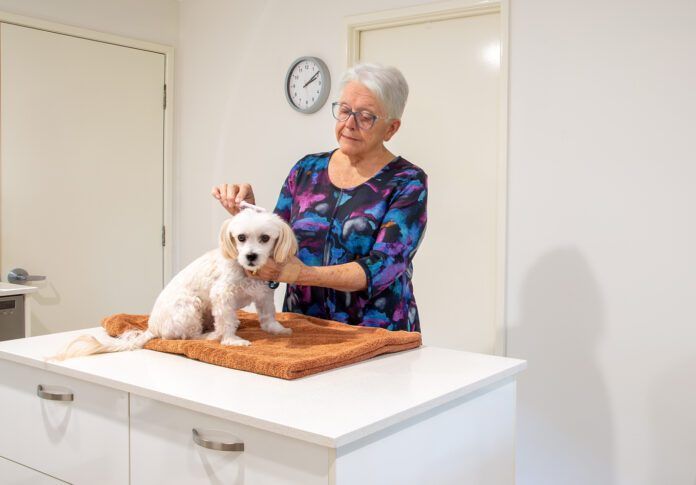
Dog grooming at home is not difficult, but you do need the right grooming supplies. Besides dog nail trimming tools and a good dog grooming scissor kit to trim hair on the feet, face, and body as needed, you need a brush that is appropriate for your dog’s coat. If you truly enjoy dog grooming at home – and are good at it – you may want to consider becoming a professional. The American Academy of Pet Grooming or the National Dog Groomers Association of America can you help you get started.
Basic Grooming Supplies for Dog Home Grooming
Whole Dog Journal is reader-supported. If you purchase through links on our site we may earn a commission. Whole Dog Journal does not accept money for its food and product reviews.
Dog nail trimming tools include nail clippers and nail grinders. Use whichever you and your dog like best, or a combination of both. For ideal nail management, trim a little bit of the claw each week. One of my favorite and best nail clippers are Miller’s Forge Designer Series Nail Scissors.
Brushing should be done on a regular basis to remove dead hair and keep your dog’s coat free of tangles. How often depends a bit on your dog. A short-haired dog like a Doberman might be OK with weekly grooming, but a long-haired dog like a Sheltie often require daily grooming. It’s far easier and quicker to groom your dog more often.
Tip: If your dog is anxious about grooming, start “grooming” with just your hand, placing your dog wherever you plan to do the actual grooming, such as on a safe table, the floor, or your lap. Let him get used to that before introducing any tools.
Other tools that you may find useful:
- Dog blow dryer that uses cool air
- Spray bottle to mist coat when brushing (reduces static)
- Electric clippers for trimming
- Shedding tools
Grooming Supplies for Short-Haired Dogs
Short-haired dogs are generally wash and wear. For dogs with a thicker coat, like a Labrador, rakes and slicker brushes are useful for removing loose hair. For dogs with a thin coat, like a Greyhound, opt for a dog grooming mitt with rubber bristles that you can use to rub your dog’s body and gently remove dead hair.
Grooming Supplies for Long-Haired Dogs
If your dog has a thick or long coat, you may need multiple brushes to manage it. Pin brushes and slickers work well for a quick “fluff and puff,” but the powerhouses are rakes and combs.
A rake with wide tines can get through dense undercoat to pull out dead hair. Then follow up with a comb to get all the way down to the skin and detangle as needed.
Tip: Mist your dog with water or a conditioning spray before brushing to reduce static and protect the hair from breakage.
Grooming shears are helpful to trim the long hair on your dog’s feet, or you can use electric clippers. If using shears, opt for a pair with blunt tips to reduce the risk of poking your dog’s skin.
If you have a Poodle, Cocker Spaniel, Shih Tzu, or other breed or mix whose hair grows a lot, it may be worth investing in a good set of electric clippers and clipper guards to shave and trim your dog’s hair at home. Note: Don’t shave your dog’s entire coat, unless instructed to do so by your veterinarian.
Groomers to the Rescue
Unsure of where to start? Contact professional groomers in your area – as your veterinarian for suggestions or check bulletin boards at local pet stores – and ask if they would be willing to teach you how to manage your dog’s coat. You will need to pay for the appointment, of course, but it is well worth it to see what tools work well for your dog’s coat type and what strategies you can use at home.
Plus, your dog will leave looking fabulous, so you start your grooming odyssey with a clean slate.
If you are nervous about certain aspects of your dog’s grooming needs, try a hybrid approach. Do maintenance coat care at home so that grooming appointments can be less often and/or less intensive.
Dog Papillomas: Viral Warts
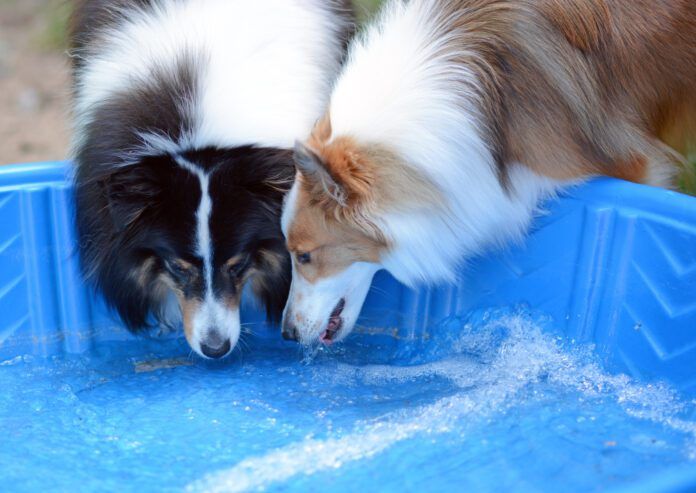
Dog papillomas are warts. These are benign little growths that are usually pink or pale in color with a cauliflower-like surface, although they can be smooth. When they are caused by a virus, they are called viral papillomas. When they occur in the mouth, they are called oral papillomas. Some warts, like the ones that develop on older dogs in random places, are not necessarily caused by a virus. These are called idiopathic non-viral papillomas or squamous papillomas.
Viral dog papillomas are contagious from dog to dog. With the dawn of dog parks and doggy day care veterinarians are seeing more cases of viral dog papillomas, especially oral papillomas in dogs. The most common papilloma virus, CPV1, is spread by direct contact with an infected dog or by sharing toys, bowls, and bedding. They are one of the reasons communal water bowls for dogs should be avoided. A break in the skin or oral mucosa is required for successful transmission. The incubation period (time from exposure to onset of symptoms) is one to two months.
Puppy Warts
Viral papillomas are most common in young dogs (under 2 years of age) and usually occur in groups or clusters in the mouth or on the muzzle, lips, eyelids and between the toes. These puppy warts are rarely a problem, most cases are mild and self-resolve within two months, which means that as long as the warts are not painful to your dog and don’t become infected, no treatment is required. Just remember they are contagious, so keep your dog away from other dogs while you wait for resolution.
Dog Papilloma Treatment
If the viral papillomas are still there after three months, treatment should be considered. Surgical removal or cryotherapy (freezing them off) are usually the treatments of choice. Other treatments that have been tried with varying success include a topical medication called imiquinod (helps the immune system fight the virus), interferon-alpha (another immune-modulating medication), azithromycin (an antibiotic that has been shown to help in some cases), cimetidine (a stomach acid-reducing medication which has shown some promise as a papilloma treatment), and, most recently, a medication called tigilanol tiglate (marketed as an injectable treatment for mast cell tumors but some suggestion it may be useful in a topical gel form for viral papilloma treatment). Torigen is a pharmaceutical company in Farmington, CT, specializing in immunotherapy for pets. They can make a vaccine for your dog using cells from your dog’s own papillomas.
Lastly, there is some thought that simply crushing one or two of the warts may help stimulate a bigger natural immune response by the dog’s body. Don’t try this yourself, however. See your veterinarian who will guide you toward the best papilloma treatment choices for you and your dog.


